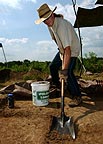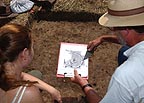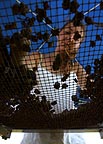June 28, 2007
Students hope to unearth mysteries of the past

Caption follows story
The focus of this year's dig is a large, circular structure on top of one of the largest mounds on the multi-mound site. What makes the work particularly challenging is that evidence for the structure is not readily visible to the naked eye without excavation, though it is easily seen in maps created with magnetometry imaging technology. A gradiometer creates the image by measuring minute variations in the strength of the Earth's magnetic field, which, at any particular spot, is influenced by what is in the ground directly beneath the gradiometer or magnetometer. Buildings typically leave magnetic evidence even after immediately visible physical evidence is gone.
Paul Welch, an associate professor in the SIUC Department of Anthropology and the director of the dig, said the circle is 22 meters across, with an area of about 4,000 square feet. The circle has projections at the four cardinal points of north, south, east and west and seems also to have an inner ring. Welch said a similar structure 27 meters across was discovered in Florida. Evidence in the historical record helped archaeologists reconstruct that site. If the two sites are as similar as they initially appear to be, the inner ring may be a row of benches and the building may be a sort of council house.
"We won't know until we dig into it," Welch said. "We are interested to find out something about the layout of the building and the settlement."
The team had success almost as soon as it began to "dig in." At just 30 centimeters down, the team uncovered the evidence they were seeking. Soil discolorations and fragments of fired daub seem to attest to two things – one, the team has uncovered a wall trench, indicating the presence of a building, and two, the building apparently burned.
Welch said buildings associated with the mound building cultures in Southern Illinois often used grass-matting and mud or clay daub in construction. The daub pieces recovered at the site show evidence of exposure to great heat.
The early success is encouraging to the field school team. "Here we are, only in the second week and already we have an idea what we are looking at," Corin Pursell, a doctoral student and a veteran of the Kincaid Mounds digs, said on-site earlier in the summer. He took a brief break from his work with shovel and trowel to explain how the team excavates square sections of the area it is studying – going down a few centimeters at a time, leveling off, measuring, and looking closely at the exposed square of soil. Variations in the soil color and composition tell a story to the trained eye. Pursell admitted, though, it can be difficult to explain to friends and family why uncovering a line of dirt can be as exciting as unearthing artifacts. In this case, finding evidence of what used to be part of a wall of a large structure gives the team a glimpse of life at Kincaid Mounds that predates the written record.
The school this year is excavating only sections of the outer wall and a section of what appears to be a fire pit in the center of the circle. "This site is not in danger, there is no immediate need to excavate all of it. To do so, in fact, would be irresponsible. Once you excavate it, you have destroyed it. We keep very clear records, but we want to leave as much of the site as we can undisturbed for future generations of archaeologists," Welch said, noting the current trend in archaeological excavation is site preservation.
Welch hopes the work this summer will uncover not only further evidence of the building but also its purpose. He wants to see how the building fits in with other structures discovered at the site. Understanding the layout of the settlement at Kincaid Mounds may provide a clue about its inhabitants – namely, their cultural identity.
Welch explained the Kincaid site was inhabited from about 1100 until about 1350 AD, at which point it, and many other sites from the Missouri bootheel to the Tennessee and Ohio River Valleys, was abandoned for unknown reasons. The area was resettled some time after 1500 by Native Americans known now as the Sauk, Fox, Illini and Peoria – native peoples still in residence when the French explorers arrived. However, these tribes do not seem necessarily to be direct descendants of the Southern Illinois mound builders.
Current archaeological study suggests two possible cultural descendants of the mound builders – those in the Siouan language family or those in the Muskogean language family. The Muskogean peoples, Welch said, tended to create settlements around a central square that included a single site for public religious observation. Siouan people, however, tended to have multiple locations for religious ceremonies.
As the site at Kincaid is slowly pieced together, and as archaeological study continues to shed light on what the settlement may have looked like, it may become clearer whether the site tends more toward the Muskogean or the Siouan model. That, in turn, may help archaeologists determine what happened to the mound builders during the widespread abandonment of the river valleys.
Past SIUC field schools have confirmed the existence of a wooden palisade surrounding much of the site, discovered a mound outside the palisade area and uncovered burned houses with evidence of thatched roofs that have helped establish the inhabited dates of the site.
"A lot of what people do doesn't leave evidence in the ground," Welch said. "Parts of the human past are exceedingly difficult for the archaeologist to get at. We do our best to leave an archaeological record for the next generation of scholars so that, even if we don't know what we are looking at, we've left a record that is clear."
Students participating in the dig are: Nina Fuscaldo, Lansing, Ill., Wesley Pinks, Chester, Ill., and graduate students Jennifer Malpiedi, currently of Carbondale, Ill., and Corin Pursell, Webster Groves, Mo. The field school began in June and concludes in August.

Caption follows story

Caption follows story
Caption:
Digging in at the SIUC Archaelogical Field School, Kincaid Mounds – Southern Illinois University Carbondale doctoral student Corin Pursell begins excavation of a section atop a mound at the Kincaid Mounds site in Massac County. He will shovel shallow layers, then use a trowel to make the layer perfectly even. Discolorations in the soil at this site reveal evidence of a wall that may have been part of a council house. The work is slow and painstaking and the sun is hot, but Pursell said he is encouraged by early success the field school has enjoyed already at the site this summer.
Photo by Jeff Garner
Magnetromic image – Southern Illinois University Carbondale Associate Professor of Anthropology Paul Welch shows undergraduate student Nina Fuscaldo a magnetromic image, taken by Massac County resident John Schwegman. The image clearly shows the ring and the central circle the team is excavating. Welch thinks the central circle, which appears as a dark spot, may have been a fire pit. The team has uncovered evidence that the ring is a wall trench, indicating the mound had a large, circular building on top of it.
Photo by Jeff Garner
Looking for clues – Southern Illinois University Carbondale undergraduate student Nina Fuscaldo sifts excavated dirt from the mound site. She has found several pieces of daub, a common building material in the Southern Illinois mound building culture, that show evidence of exposure to great heat.
Photo by Jeff Garner
